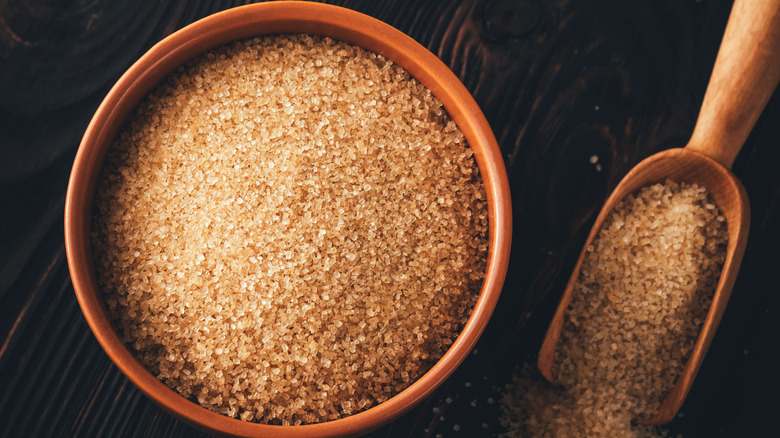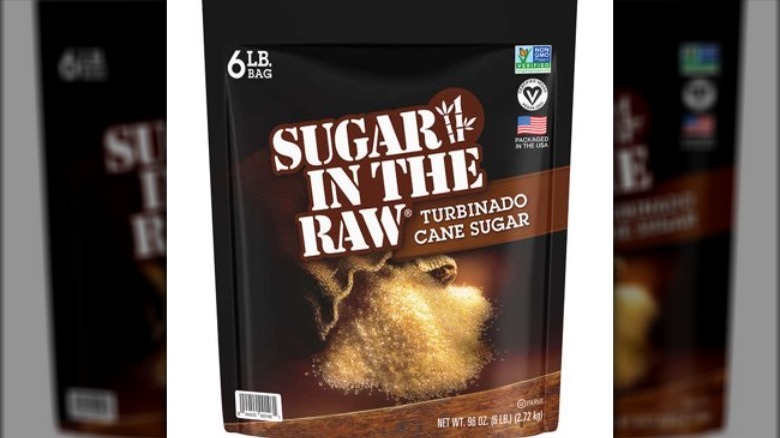Brown Sugar Vs. Turbinado Sugar: What's The Difference?
Whether you're baking up some delicious treats or sweetening your morning coffee, sugar is used in many of our favorite foods and drinks throughout the day. The recommended daily intake of sugar varies slightly depending on gender, per the American Heart Association: Men should consume no more than nine teaspoons per day, while women are limited to six. Still, indulging in a little extra sweetness can help us start off the morning in a great way with your favorite latte, or end it on a high note with a sweet treat after dinner.
Though we typically think of the fine, white granules when we go to buy sugar, there are a number of different varieties available in most grocery stores. Depending on what purpose you're using the sugar for, it can be important to note the differences between the types. Brown sugar and turbinado sugar are two varieties typically found in the baking aisle, but what exactly is the difference between them, and can they be swapped out for one another?
What is brown sugar?
Brown sugar is named for its appearance, which is due to the presence of molasses, per Food Insight. The molasses, which comes from sugar cane, alters the flavor and moisture of brown sugar, making it distinct from white sugar. It is commonly used in baked goods (especially around the holidays when it's time to bake gingerbread). Although Food Insight notes that molasses can have some health benefits, brown sugar is not considered healthier than any other kind of sugar. In fact, it has nearly the same number of calories as white sugar.
There are two types of brown sugar, though they are pretty similar. Light and dark brown sugar both contain molasses, but in varying amounts. Dark brown sugar typically has more molasses content, giving it a stronger flavor and a little more moisture than its lighter counterpart, according to Imperial Sugar. The varying amounts of moisture in brown sugar can alter its texture; some brown sugar is coarse, while some is softer.
How is Turbinado sugar different?
If you've ever seen Sugar in the Raw at your local coffee shop, you're probably familiar with turbinado sugar. According to The Kitchn, the coarse, minimally-refined sugar is often used in coffee, tea, and baking. Though its color makes it appear similar to brown sugar, it actually contains far less molasses than light brown sugar — only trace amounts, per Bon Appétit. Its subtle caramel flavor adds an extra dimension of sweetness to anything it's added to.
Healthline states that turbinado sugar is made from sugarcane that is boiled to thicken and crystallize the sugar. It contains trace amounts of iron, calcium, and antioxidants. However, it shouldn't be considered a healthy food since the quantities of these nutrients are so low. Instead, it works better as a flavor enhancer. Its nutritional value is comparable to white sugar, though turbinado sugar can sometimes cost up to three times as much as its more refined counterpart.
Can you swap them when baking?
If you find yourself baking a recipe that calls for brown sugar but you only have turbinado on hand, fret not. The Spruce Eats notes that the two sugars are easily interchangeable thanks to their similar molasses contents and caramel flavors. In fact, the two sugars can be swapped at an equal one-to-one ratio. Though they function essentially the same, there are a few key differences to note when swapping one out for the other.
According to Spiceography, the biggest difference will be found in the color of your completed baked goods. Since turbinado sugar is lighter in color than most brown sugars, the finished product will have a paler appearance if turbinado sugar is swapped in. The site also notes that turbinado sugar's flavor is more subtle than the molasses of brown sugar, so the taste may be slightly different than what you are used to. Turbinado sugar also features larger sugar crystals, so it could take longer to break down and melt in your baked goods.



